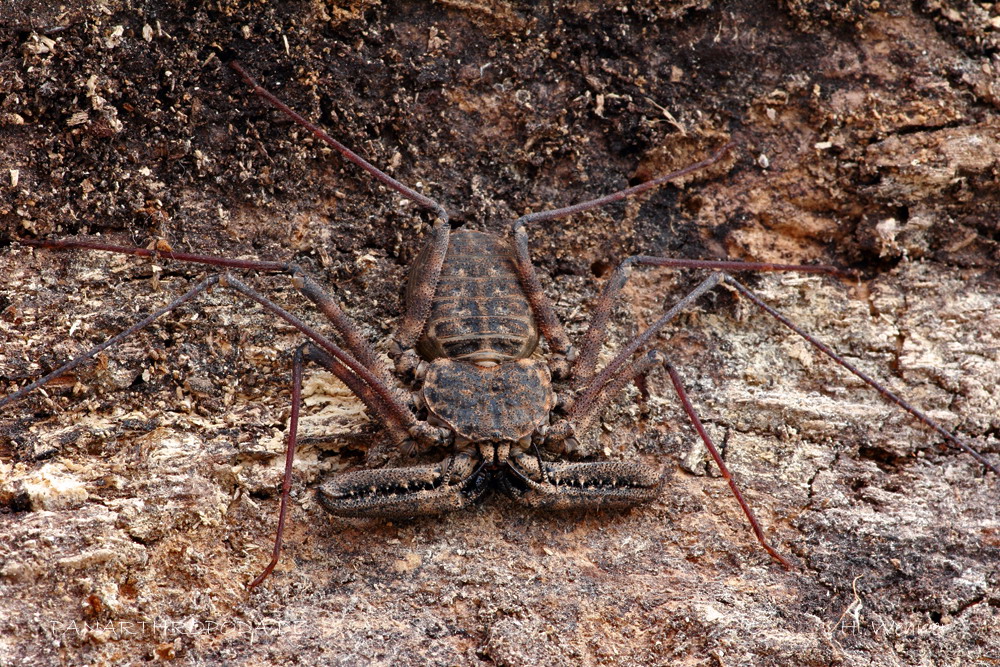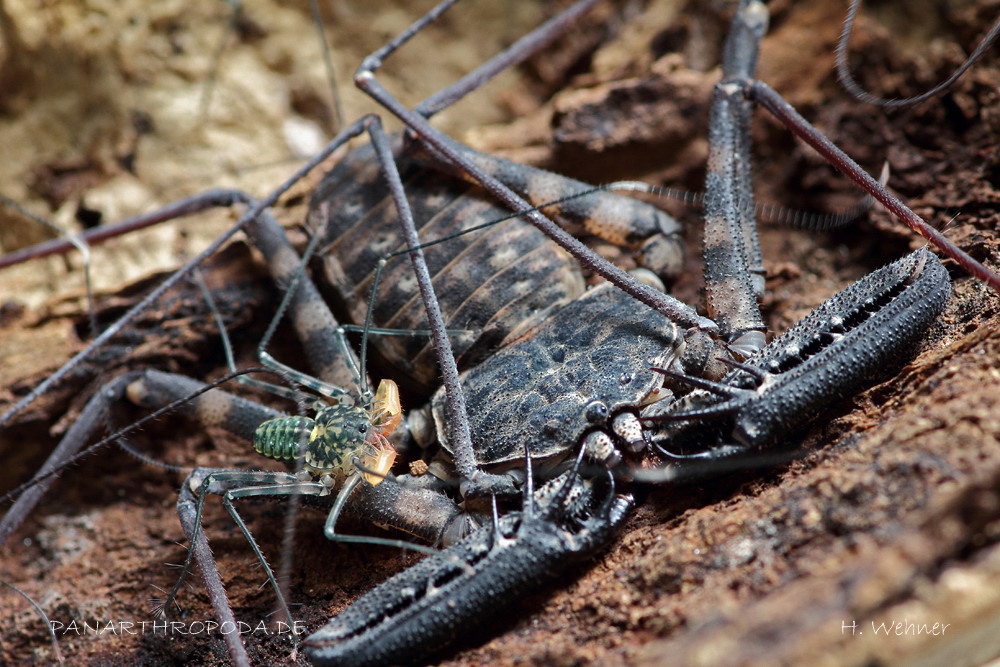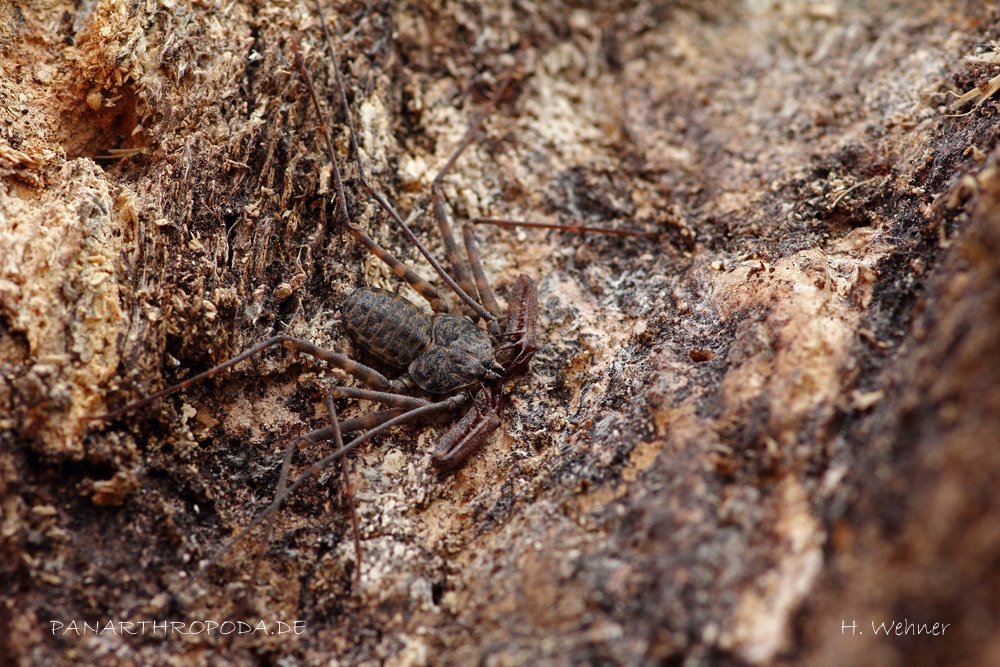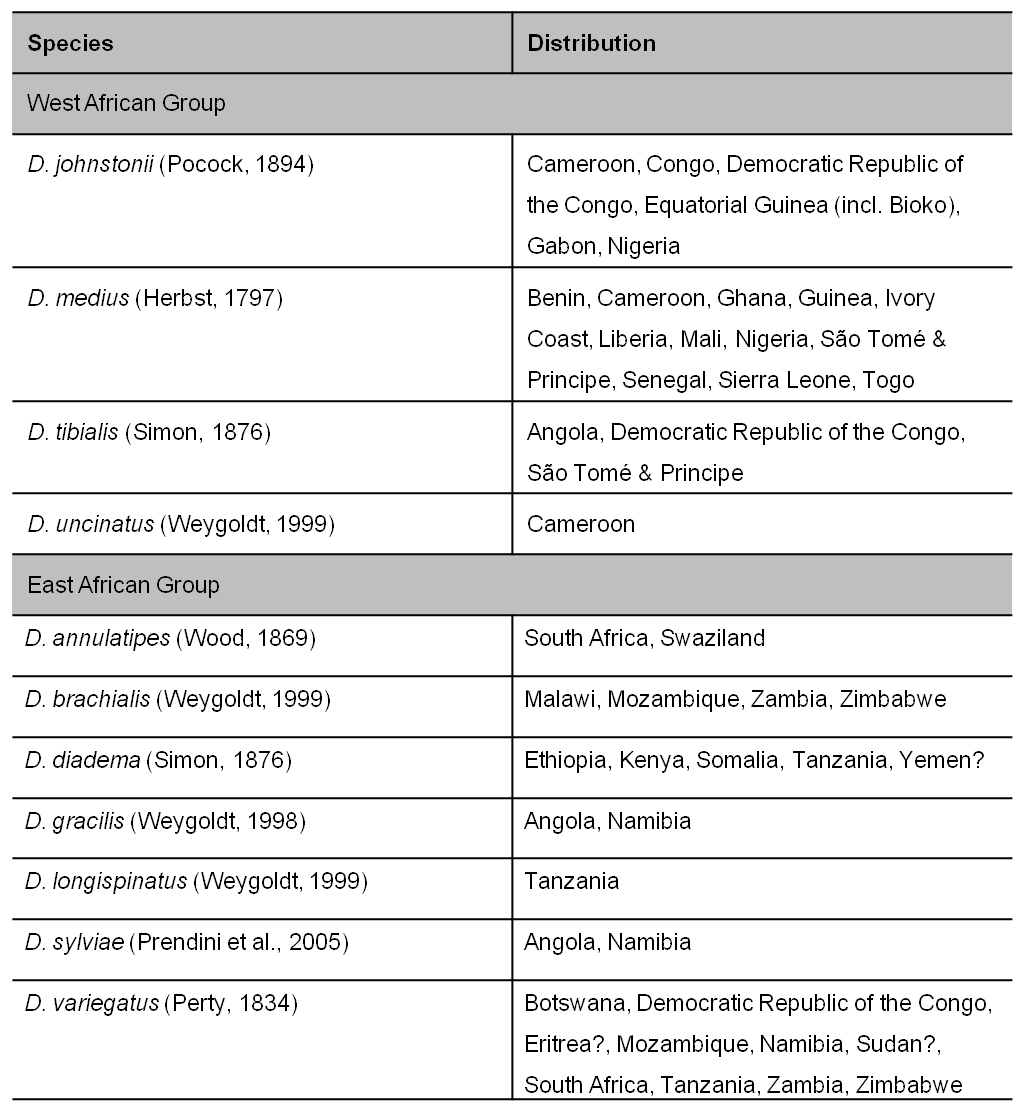
The genus Damon (C.L. Koch)

Damon annulatipes male
The genus Damon includes the most whip spider species on the African continent and has a wide distribution in sub-Saharan Africa (Prendini et al., 2005).
11 species are described as belonging to the genus Damon but it can be assumed that more Damon species will be described given that Damon variegatus most likely represents more than one cryptic species (Prendini et al., 2005). All Damon species possess robust pedipalps which form a terminal prehensile hand. The spines forming this prehensile hand are straight and not bend as it is the case in species belonging to the genus Phrynichus (Weygoldt, 2000).
The genus Damon is monophyletic and shows two autapomorphies: Leaf-like setae which are located on the tarsal segments of the antenniform legs and pleural folds on the opisthosoma which cover the egg sac laterally or even ventrally to form brood pouches (Prendini et al., 2005). The formation of brood pouches is most likely an adaption in response to dry habitats. Highly developed brood pouches, where the egg sac is covered with pleurae even ventrally, can be found in species belonging to the East African group which lives in especially dry habitats like D. variegatus, D. sylviae and D. gracilis (Prendini et al., 2005).
The genus Damon can be divided in two groups (Prendini et al., 2005). The West African group consisting of D. johnstonii, D. medius, D. tibialis and D. uncinatus is distributed up to Senegal in the north along the West African coast to western Congo (Prendini et al. 2005; Weygoldt, 2000). This group is characterized by the occurence of ventral sac covers and their great size (30-40 mm). This group most likely is a paraphyletic assemblage because D. medius might be the sister taxon of the East African grouping within the genus Damon (Prendini et al. 2005; Weygoldt, 2000). Concerning D. uncinatus it is discussed if this species might be the sister taxon of the remaining Damon species taking account of the complex female genitalia (Weygoldt, 2002).
The East African group (also designated D. variegatus-group) indeed most likely is monophyletic. This group consists of the remaining Damon species. Species of the D. variegatus-group lack ventral sac covers and additionally can be distinguished by the spermatophore morphology and their lesser size (25-30 mm) (Prendini et al. 2005; Weygoldt, 2000).

Damon diadema female with instar 2 young

Damon tibialis
Table 1: The species belonging to the genus Damon and their distribution (modificated after Prendini et al., 2005).

Except D. medius, which also occurs in savannah-like habitats, Damon-species belonging to the West African group live in forests (Weygoldt, 2000).
The genus Damon underwent an extensive adaptive radiation and it is assumed that its origin lays in the West African rainforests. The D. variegatus-group could have spread from there to central Africa extend to East Africa, South Africa and finally reach South West Africa (D. gracilis and D. sylviae) (Weygoldt, 2000).
Prendini et al. (2005) demonstrated that Damon variegatus most likely at least consists of two species so that a former D. variegatus population from Namibia and southern Angola were redescribed as D. sylviae. D. variegatus and D. sylviae are sister species, that are separated by the Kalahari Desert.
Beside the question if the remaining D. variegatus population represents a single species it is discussed, if D. variegatus represents a paraphyletic assemblage, because numerous morphological traits seemingly are plesiomorphic compared to other species belonging to the D. variegatus-group (Prendini et al., 2005; Weygoldt, 2000). This could disclose, that D. variegatus represents a central group from which the other East African Damon-species arose which would show that D. variegatus is not monophyletic (Weygoldt, 1999). Findings of Prendini et al. (2005) however back up the monophyly of D. variegatus.
Identification key that leads to the genus Damon (from Weygoldt, 2000)
Precondition is the identification leading to the family Phrynichidae (inclusively Xerophrynus) (therefore see section “The family Phrynichidae”).
The tibia of the pedipalp shows three spines dorsally. The first two (counted beginning distally) are shifted to the distal end of the tibia. Together with the tarsus they form a prehensile hand.
Yet missing picture
The proximal dorsal third spine of the pedipalp tibia is reduced in many species or disappears completely during post-embryonic growth.
Yet missing picture
The upper cusp of the bicuspidate first denticle of the intern respectively the median denticle row of the first article of the chelicera is bigger than the lower one.
Yet missing picture
Basitibia of walking leg IV is divided in two articles.
Yet missing picture
The ventral spine I of the tibia of the pedipalp is not divided.
Yet missing picture
No tubercles can be found above the cleaning organ of the pedipalp distitarsus.
Yet missing picture
References
Prendini, L. (2005). Systematics of the group of African whip spiders (Chelicerata: Amblypygi): Evidence from behaviour, morphology and DNA. Organisms Diversity & Evolution, 5, 203-236.
Weygoldt, P. (1999). Revison of the genus Damon C. L. Koch, 1850 (Chelicerata: Amblypygi: Phrynichidae). Zoologica (Stuttgart), 150, 1-45.
Weygoldt, P. (2000). Whips Spiders (Chelicerata: Amblypygi). Their Biology, Morphology and Systematics. Apollo Books, Stenstrup, DK.
Weygoldt, P. (2002). Fighting, Courtship, and Spermatophore Morphology of the Whip Spider Musicodamon atlanteus Fage, 1939 (Phrynichidae) (Chelicerata, Amblypygi). Zoologischer Anzeiger - A Journal of Comparative Zoology, 241, 245-254.
F. Schramm, authored 2011